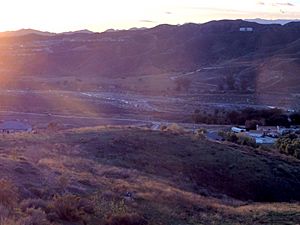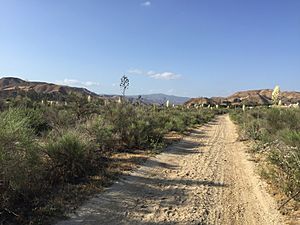San Francisquito Creek (Santa Clara River tributary) facts for kids
Quick facts for kids San Francisquito Creek |
|
|---|---|
 |
|
| Native name | Arroyo San Francisquito |
| Country | United States |
| State | California |
| Region | Los Angeles County |
| Physical characteristics | |
| Main source | southwest of San Francisquito Pass 34°38′12.62″N 118°23′5.86″W / 34.6368389°N 118.3849611°W |
| River mouth | confluence with Santa Clara River 34°25′34.21″N 118°34′9.26″W / 34.4261694°N 118.5692389°W |
| Length | 22 mi (35 km) |
| Basin features | |
| River system | Santa Clara River |

San Francisquito Creek is a stream in Los Angeles County, California. It flows into the Santa Clara River. This creek collects water from the southern parts of the Sierra Pelona Mountains. These mountains are part of the larger San Gabriel Mountains range.
The town closest to the creek's upper part is Green Valley. The creek starts near San Francisquito Pass. Where the creek meets the Santa Clara River, you'll find the city of Santa Clarita.
History of San Francisquito Creek
San Francisquito Creek was originally known as the Arroyo San Francisquito. For many years, the creek and its canyon were a very important path. It was the main route for wagons and stagecoaches traveling north from Los Angeles to the San Joaquin Valley.
Old Travel Routes Along the Creek
One of the first routes was called El Camino Viejo. Later, the Stockton–Los Angeles Road followed this path. The famous Butterfield Overland Mail stagecoach route also used the canyon. These old wagon roads followed the creek's path at the bottom of the canyon.
Two places where stagecoaches would stop for rest, called stage stations, were located along the creek. One was Widow Smith's Station, about 1 mi (1.6 km) down the canyon from Green Valley. Another was King's Station, located 10 mi (16 km)* south of Widow Smith's Station.
The St. Francis Dam Disaster
The St. Francis Dam was built on San Francisquito Creek. It was finished in 1926. This dam was part of the Los Angeles Aqueduct system. It helped store water brought from the Owens Valley.
However, the dam broke in 1928. This happened because of a hidden weakness in the ground beneath it. When the dam failed, a huge wave of water and debris rushed down the canyon. It then flowed into the Santa Clara River Valley and out to the sea. This event caused a great loss of life. You can still find some of the debris from the dam in the creek bed today.

